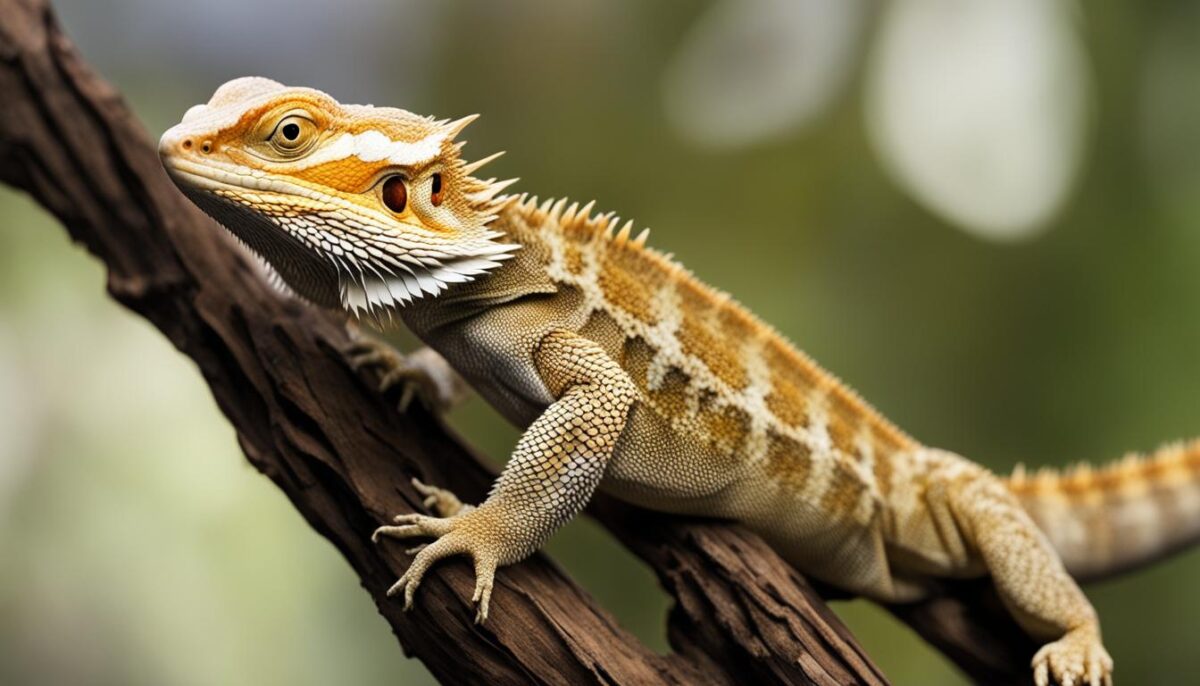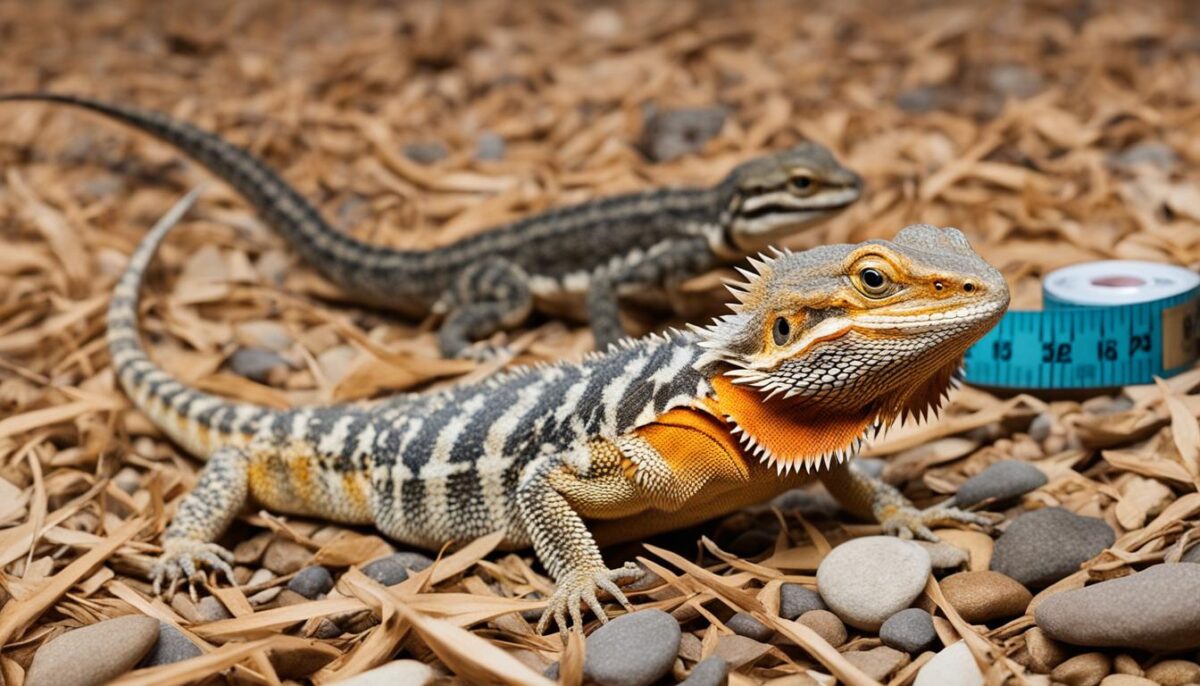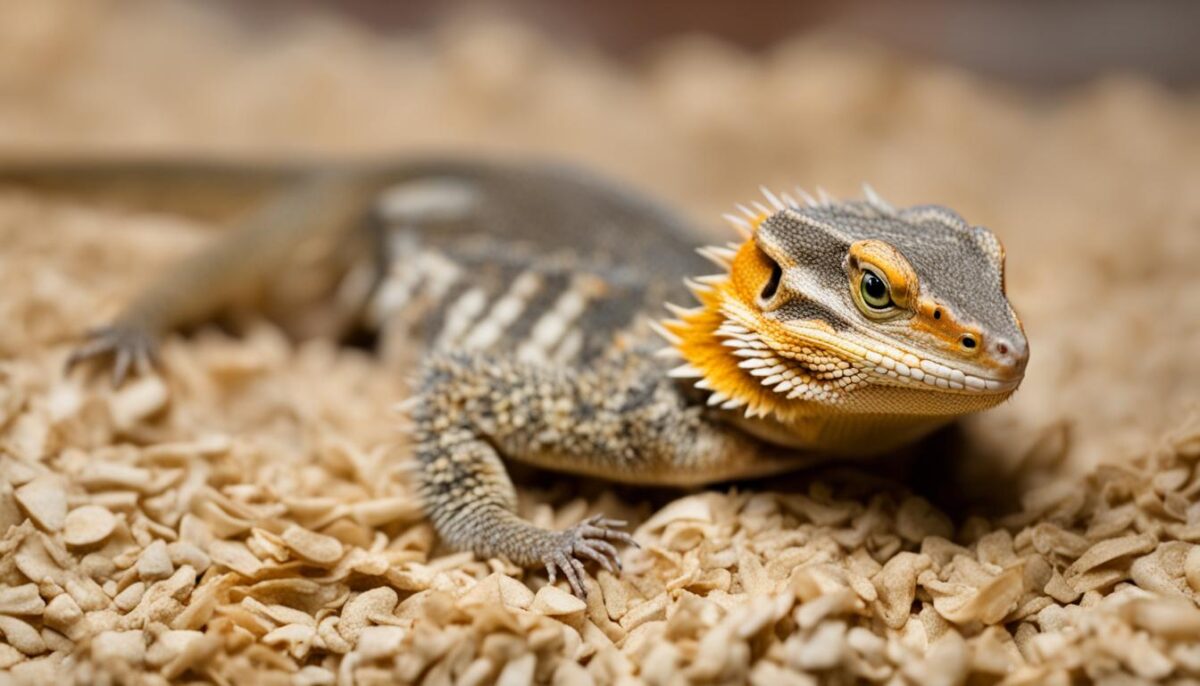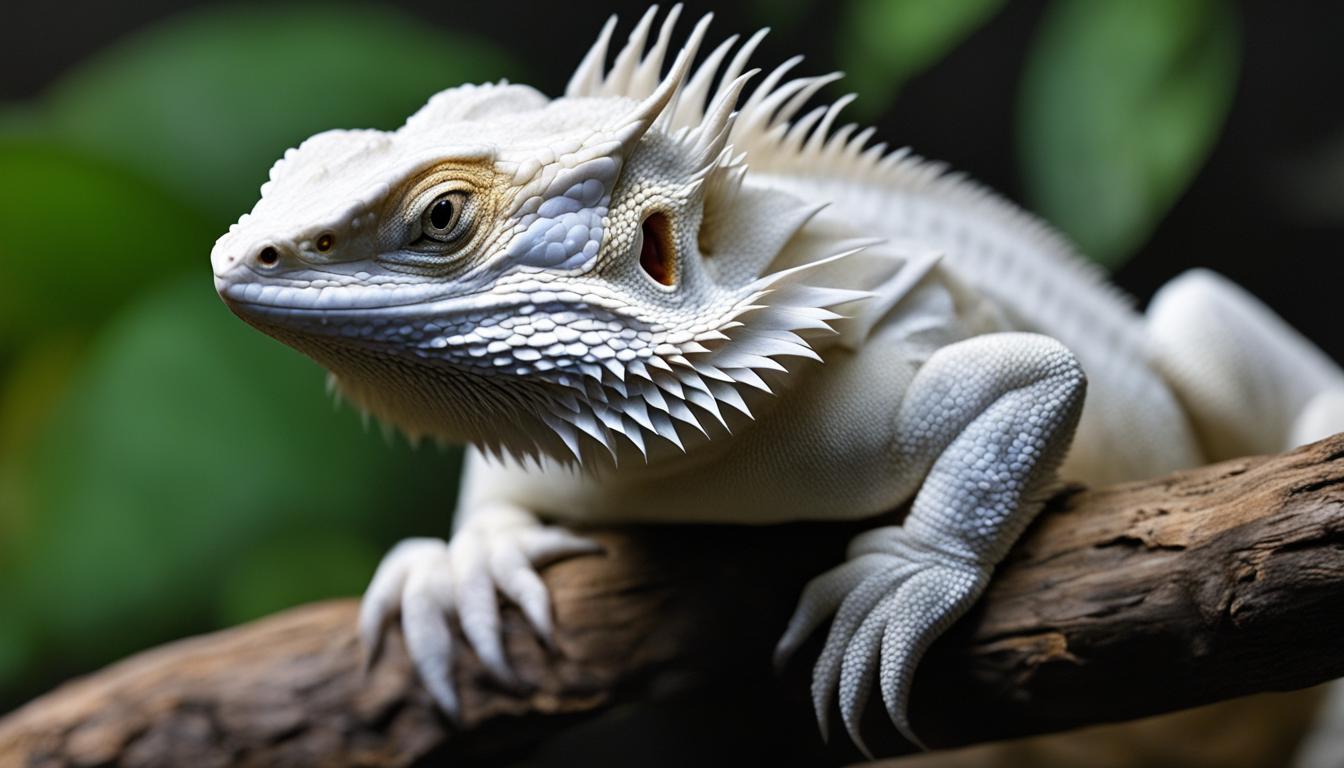If you’re searching for a rare and unique addition to your exotic pet collection, look no further than white bearded dragons for sale. These stunning reptiles, also known as morphs, come in a variety of colors and scale types, ranging from red to hypo, inferno, and citrus. As a responsible bearded dragon breeder, we offer some of the best quality and most beautiful specimens. White bearded dragons are highly sought after, and their prices vary depending on their morph and genetics. It’s important to provide proper care and habitat for these magnificent creatures, as they can grow up to 2 feet in length and have a lifespan of 6-10 years in captivity.
Key Takeaways:
- White bearded dragons are rare and unique additions to exotic pet collections.
- They come in a variety of colors and scale types, making them visually stunning.
- Prices for white bearded dragons vary based on their morph and genetics.
- Proper care and habitat are essential for their health and well-being.
- They can grow up to 2 feet in length and have a lifespan of 6-10 years in captivity.
About Bearded Dragons
Bearded dragons are fascinating reptiles known for their unique behaviors and stunning appearance. By waving their arms and extending their spiny “beard,” they communicate and display submissive gestures. There are different kinds of bearded dragons, each with its own distinct morphs and scale types.
Baby bearded dragons are generally flighty at first but can quickly become tame and relaxed pets. It’s important to choose a reputable bearded dragon breeder when purchasing one, as they can offer the best quality and provide proper care information.
“Bearded dragons are amazing creatures to have as pets. Their interactive behaviors, like arm waving, make them truly captivating. When I first got my baby bearded dragon, it was skittish, but with patience and gentle handling, it became a loving and friendly companion.” – Sarah, a proud bearded dragon owner
The Various Types of Bearded Dragons
Bearded dragons come in a variety of types, each with its own unique characteristics. Here are some popular types:
- Inland Bearded Dragons: One of the most common types. They have a mix of colors and patterns and are known for their calm temperament.
- German Giants: These bearded dragons are known for their larger size and strong build. They can grow up to 24 inches in length.
- Leatherback Bearded Dragons: Their scales are smooth and lack the spiky appearance of other types. They have a reduced scale size, giving them a “leathery” appearance.
- Silkback Bearded Dragons: This unique morph lacks scales, resulting in a smooth, almost velvet-like skin. Extra care is required to protect their sensitive skin from injuries.
- Citrus Bearded Dragons: These dragons have bright orange or yellow coloration, giving them a vibrant and eye-catching appearance.
Why Choose a Bearded Dragon as a Pet?
Bearded dragons make great pets for many reasons:
- Low Maintenance: They are relatively low-maintenance pets, requiring a simple diet and basic habitat setup.
- Gentle Temperament: Bearded dragons are known for their calm and docile temperament, making them perfect for handling and interaction.
- Long Lifespan: With proper care, bearded dragons can live up to 10 years or more.

| Type | Price Range* |
|---|---|
| Inland Bearded Dragon | $50 – $150 |
| German Giant | $150 – $250 |
| Leatherback Bearded Dragon | $150 – $350 |
| Silkback Bearded Dragon | $200 – $500 |
| Citrus Bearded Dragon | $200 – $400 |
*Prices may vary depending on the breeder, morph, and availability.
Bearded Dragon Care and Habitat
Proper care and habitat are crucial for the health and well-being of bearded dragons. These unique reptiles require specific living conditions to thrive and lead a happy life.
Caring for Your Bearded Dragon
When it comes to bearded dragon care, there are several important factors to consider. These include providing the right housing, lighting, temperature, and a balanced diet.
Let’s start with the housing. Hatchlings can temporarily live in a 20-gallon aquarium, but as they grow, adult dragons will require a larger enclosure. A 75-gallon aquarium or equivalent will provide them with the space they need to move around and explore.
It’s important to ensure proper ventilation in their habitat by using screens on the tank or enclosure. This will ensure they have access to fresh air while keeping them secure.
Bearded dragons are native to arid regions, so it’s essential to incorporate both sunny basking areas and shady retreats in their outdoor enclosures. This will allow them to regulate their body temperature by moving between different areas.

As baby bearded dragons grow, it’s important to monitor their size and ensure they are developing properly. Providing a suitable habitat, including a properly sized enclosure, and a balanced diet are crucial for their growth and overall well-being.
Factors Affecting Bearded Dragon Size and Lifespan
Several factors can influence the size and lifespan of bearded dragons:
- Nutrition: Proper nutrition is essential for healthy growth. A diet consisting of a variety of insects, vegetables, and greens will provide the necessary nutrients for optimal development.
- Environment: Temperature, UVB lighting, and habitat setup play a significant role in a bearded dragon’s growth and overall health. Maintaining appropriate temperatures and providing adequate UVB exposure are crucial.
- Genetics: Different morphs and genetic traits can impact the size and overall lifespan of bearded dragons. Some morphs may have shorter lifespans compared to others.
- Healthcare: Regular veterinary check-ups and proper healthcare practices, including parasite prevention, are essential for ensuring a bearded dragon’s longevity.
By providing a suitable environment, proper nutrition, and regular veterinary care, you can help maximize the size and lifespan of your bearded dragon.
“Proper care plays a crucial role in the size and lifespan of bearded dragons. By offering a balanced diet, suitable habitat, and regular healthcare, you can help your dragon thrive and live a long, healthy life.” – Dr. Samantha Carter, Herpetologist
Choosing the Right Substrate
The choice of substrate for your bearded dragon’s enclosure is essential. It directly impacts their health and well-being, making it crucial to select the most suitable option. When it comes to substrate options for bearded dragons, it’s important to consider the age of your pet and the potential risks associated with each choice.
For adult bearded dragons, sand is a commonly used substrate. It mimics their natural environment and allows for natural digging behaviors. However, it’s essential to ensure that the sand is properly moistened to prevent respiratory issues. Additionally, regular cleaning and monitoring are necessary to avoid impaction, a condition that can occur if your pet ingests sand while feeding.
For younger bearded dragons, sand is not recommended due to the higher risk of impaction. Safer options include newspaper, paper toweling, or reptile carpet. These substrates are easy to clean and provide a hygienic environment for your young pet. They also eliminate the risk of accidental ingestion, ensuring the well-being of your growing bearded dragon.
If you choose to use sand, there are alternative options available to reduce the risk of impaction. Playground sand or reptile sand mixed with clean soil can provide a more digestible substrate. This mixture allows for natural digging behaviors while minimizing the chances of blockages in the digestive system.
Remember, no matter which substrate you choose, it’s crucial to provide a shallow dish for feeding. This helps prevent accidental ingestion of substrate while your bearded dragon enjoys its meal.
Key points:
- Adult bearded dragons: Sand is commonly used, but proper moisture levels and cleaning are crucial. Impaction can be a concern, so careful monitoring is necessary.
- Youth bearded dragons: Newspaper, paper toweling, or reptile carpet are safer options. These substrates eliminate the risk of impaction and provide a hygienic habitat for young dragons.
- Alternative sand options: If using sand, consider mixing playground sand or reptile sand with clean soil to reduce the risk of impaction. This allows for natural digging behavior while prioritizing digestive safety.
- Feeding dish: Regardless of the substrate, provide a shallow dish for feeding to prevent accidental ingestion.

Choosing the right substrate is crucial for the health of your bearded dragon. Consider their age and the potential risks associated with each option. Whether you opt for sand, alternative mixtures, or safer substrates like newspaper or reptile carpet, providing a suitable environment will ensure the well-being of your reptilian companion.
Handling and Behavior of Bearded Dragons
Bearded dragons are fascinating reptiles with unique behaviors that make them beloved pets. Unlike some other lizard species, they are generally docile and can tolerate handling quite well. Regular handling from a young age can help them become friendly and comfortable with human interaction. When properly handled, bearded dragons can develop a bond with their owners and enjoy being held and touched.
One of the most distinctive behaviors of bearded dragons is their arm waving. They often wave their arms in a slow motion to communicate with other dragons or show submission to perceived threats. This behavior is both intriguing and entertaining for reptile enthusiasts.
Aggressive displays are rarely seen in captive bearded dragons, especially if they have been properly socialized from a young age. They are more likely to display a calm and relaxed demeanor. However, it’s important to note that each bearded dragon has its own unique personality and may react differently to various stimuli.
Proper Handling Techniques
When handling a bearded dragon, it’s essential to follow proper techniques to ensure their safety and well-being:
- Approach the bearded dragon calmly and confidently, using slow and gentle movements.
- Support the dragon’s body by placing one hand under its chest and another hand under its abdomen.
- Avoid grabbing the bearded dragon by the tail, as it can cause them stress and discomfort.
- Allow the dragon to explore your hand or arm at its own pace, gradually lifting it off the ground.
- Never squeeze or apply pressure to the dragon’s body.
- Always wash your hands before and after handling a bearded dragon to prevent the spread of bacteria.
Creating a Suitable and Stress-Free Environment
In addition to proper handling, it’s important to provide your bearded dragon with a suitable and stress-free environment. Here are some key factors to consider:
- Temperature: Maintain a temperature gradient in their habitat, with a basking spot around 100 degrees Fahrenheit (37 degrees Celsius) and a cooler end around 80 degrees Fahrenheit (27 degrees Celsius).
- Lighting: Bearded dragons require UVB lighting for proper calcium absorption. Ensure they have access to full-spectrum UVB lighting for a healthy bone development.
- Habitat: Set up a spacious enclosure with hiding spots, branches, and rocks for climbing and basking. Provide a shallow dish for water and a substrate that is safe and easy to clean.
- Diet: Offer a balanced diet consisting of live insects, leafy greens, vegetables, and occasional fruits.
By handling your bearded dragon correctly and providing them with a stress-free environment, you can establish a strong bond with these captivating reptiles and ensure their well-being.
Finding a Reputable Bearded Dragon Breeder
When looking to purchase a bearded dragon, it’s crucial to choose a reputable breeder. Bearded dragons are commonly available at pet stores, reptile expos, and online, but a dedicated breeder will provide the best quality and care information. Captive-bred specimens are recommended for their health and calm temperament. Reputable breeders can offer a variety of colors and morphs, including white bearded dragons.
If you’re in the market for a baby bearded dragon, finding a trustworthy bearded dragon breeder is essential. Reputable breeders prioritize the well-being and health of their dragons, ensuring that they are captive-bred and ethically raised. By purchasing from a reputable breeder, you can have peace of mind knowing that your baby bearded dragon comes from a reliable source.
One advantage of buying a baby bearded dragon from a breeder is the wealth of information and guidance they can provide. A reputable breeder will offer valuable advice on proper care, habitat setup, and feeding requirements to ensure your baby dragon grows up healthy and happy. Their expertise can help you navigate any challenges that may arise and ensure the best possible start for your new pet.
When searching for a bearded dragon breeder, take the time to research their reputation and reviews. Look for breeders who have a history of satisfied customers and positive feedback. It’s also a good idea to visit the breeder in person or connect through video calls if purchasing online. This allows you to assess the conditions in which the bearded dragons are raised and interact with the breeder directly.
Additionally, reputable breeders will provide transparent and accurate information about the lineage and genetics of their dragons. They should be able to answer any questions you have about the specific morphs or color variations available. This ensures that you can make an informed decision based on your preferences and expectations.
Remember, a reputable bearded dragon breeder’s primary concern is the well-being of their dragons and the satisfaction of their customers. They will prioritize providing healthy and well-acclimated baby bearded dragons for sale, ensuring that the transition to their new homes is smooth and stress-free.
When you find a reputable bearded dragon breeder, you not only gain a beautiful and unique pet but also the ongoing support and resources necessary for responsible ownership. Investing in a reputable breeder ensures the best chance of a long and rewarding relationship with your bearded dragon.
Conclusion
In conclusion, white bearded dragons are truly rare and stunning creatures that would make a unique addition to any exotic pet collection. These mesmerizing reptiles with their one-of-a-kind morphs and genetics are highly sought after by reptile enthusiasts worldwide.
However, it’s important to remember that owning a white bearded dragon comes with great responsibility. Ensuring their well-being and longevity requires providing them with proper care, a suitable habitat, and gentle handling. By selecting a reputable bearded dragon breeder, you can acquire a companion that will offer you years of joy and companionship.
Take the time to find a breeder who is knowledgeable about bearded dragons and has a proven track record of breeding healthy and vibrant specimens. With their expertise and guidance, you can navigate the fascinating world of rare bearded dragons for sale and find the perfect reptile companion that suits your preferences and lifestyle.
FAQ
Where can I find white bearded dragons for sale?
You can find white bearded dragons for sale from reputable bearded dragon breeders, pet stores, reptile expos, and online platforms.
How much do white bearded dragons cost?
The price of white bearded dragons can vary depending on their morph and genetics. It is best to check with specific breeders or sellers for accurate pricing information.
What care do white bearded dragons require?
White bearded dragons require proper care, including a suitable habitat with adequate space, proper lighting, temperature regulation, a balanced diet, and access to clean water.
How large do white bearded dragons grow?
White bearded dragons can grow up to 2 feet in length when they reach adulthood.
What are the different morphs of white bearded dragons?
White bearded dragons come in a range of morphs, including red, hypo, inferno, and citrus. Each morph has its own unique colors and scale types.
What is the lifespan of a white bearded dragon?
White bearded dragons typically have a lifespan of 6-10 years in captivity, although some specimens have been reported to live even longer.
What substrate should I use for my bearded dragon’s enclosure?
While sand is commonly used for adult dragons, it is not recommended for younger ones due to the risk of impaction. Safer options for younger bearded dragons include newspaper, paper toweling, or reptile carpet.
How should I handle my bearded dragon?
Bearded dragons are generally docile and can tolerate handling. Regular handling from a young age can help them become friendly and comfortable pets. It’s important to handle them correctly and provide them with a suitable and stress-free environment.
Where can I find a reputable bearded dragon breeder?
Reputable bearded dragon breeders can be found through recommendations, reptile expos, or online platforms specializing in reptile sales.


